How To Make Sauerkraut
This post may contain affiliate links. See my disclosure policy.
A comprehensive, step-by-step pictured tutorial on How to Make Sauerkraut that is incredibly healthy and delicious! Making your own fermented homemade sauerkraut is super easy, requires minimal prep work, and the rest is just a waiting game. This Sauerkraut recipe covers everything you need to know to ensure your success!
For another probiotic-packed food, be sure to check out my tutorial for How to Make Yogurt!
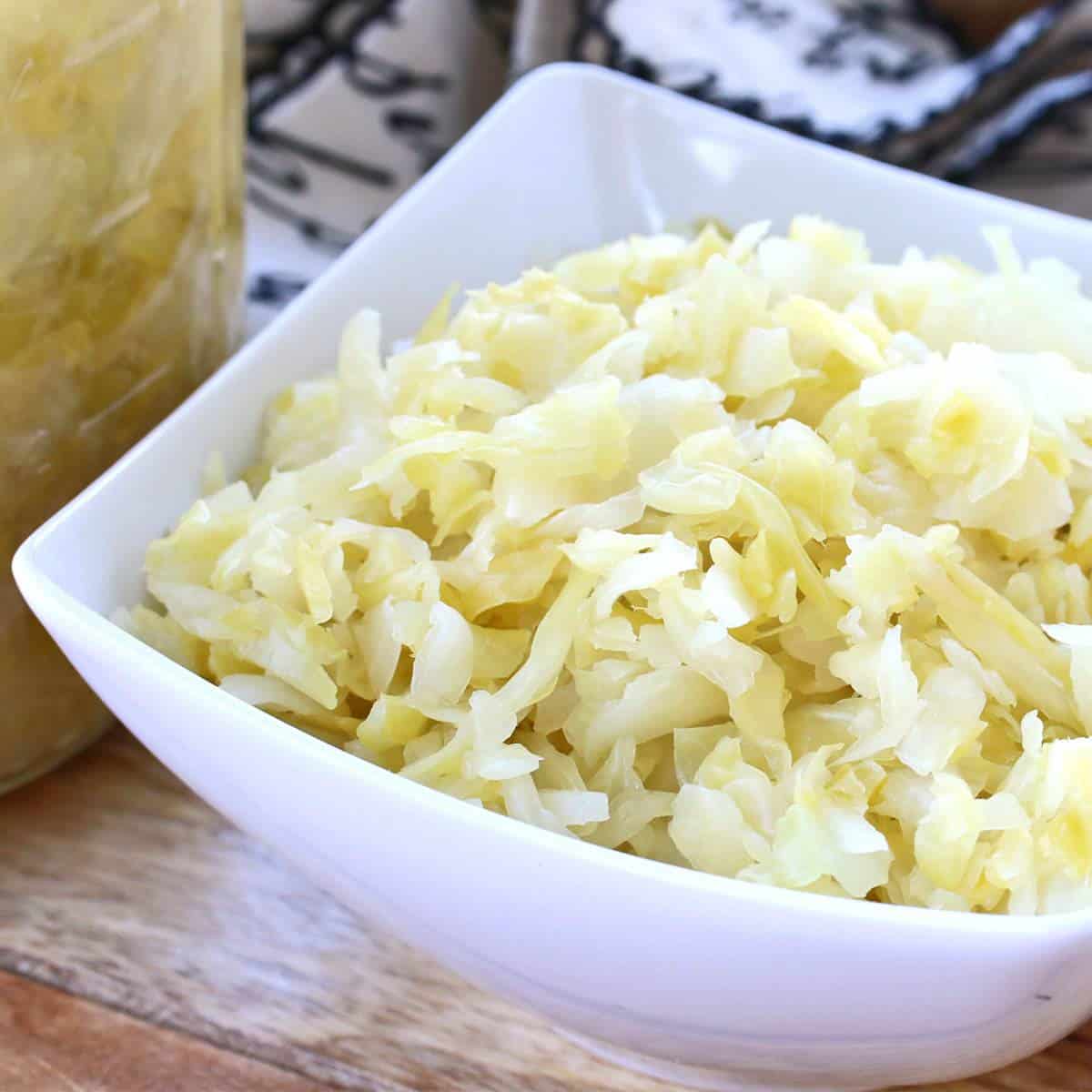
Sauerkraut is in my blood. Being from Germany and raised by a health-conscious mom, I ate this stuff on a regular basis. In Germany sauerkraut is eaten fresh or cooked in a wide variety of dishes; everything from casseroles and soups to salads or alongside meats and sausages. Raw fermented sauerkraut was always readily available in our local health food stores. My mom and I regularly went to our local Reformhaus and in the refrigerated section was a large vat of fresh sauerkraut where we could scoop out as little or as much as we wanted into the bags provided. We’d often nibble on some of it as we made our way through the outdoor shopping district and then take the rest home with us. This ancient skill has been making a comeback in recent years both overseas and in the U.S., with a growing number of people learning how to ferment their own foods.
I’ve been fermenting vegetables, grains, legumes, and dairy products for over a decade and it is a deeply satisfying venture. If you’ve been curious about how to make sauerkraut it’s time to make that leap. For anyone interested in trying their hand at fermentation, sauerkraut is the perfect place to start!
Why You Should Make Your Own Sauerkraut
The benefits of probiotics are well-established and the fact that you’re here reading this means you’re already aware of that. And you’re probably also aware that there is no better or easier way to access a wide spectrum of probiotics than making your own sauerkraut. With probiotic supplements you’re limited to a couple or few select strains. Research has shown homemade fermented sauerkraut to contain as many as 28 separate and distinct strains. No probiotic pill can replicate that. Not to mention that there is no way to verify how much of the bacteria is even still alive in probiotic supplements.
With homemade fermented sauerkraut you’re benefitting not only from a large variety of probiotic strains, you’re also getting a large dose of live, healthy, and robust ones.
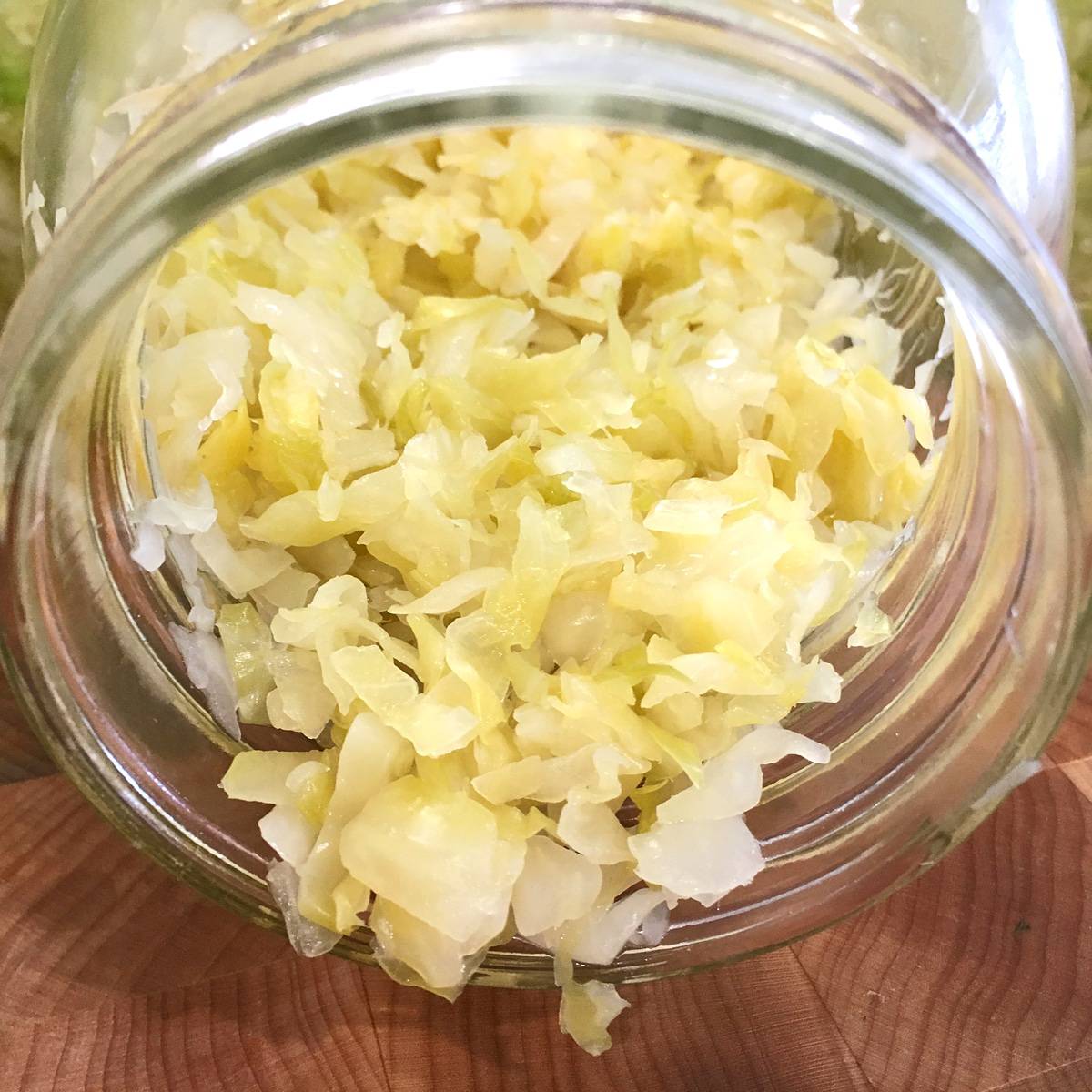
Equipment For Making Sauerkraut
You don’t need any specialized equipment to make sauerkraut.
- A large glass or ceramic jar (I regularly use half gallon Mason jars)
- Some kind of heavy, flat-bottomed tamper for crushing the cabbage
- Something flat to weigh down the cabbage that’s relatively close in size to the diameter of the jar you’re using
- Fresh cabbage
- Salt (sea salt or kosher salt)
That’s it. You don’t need any specialized tools, gadgets, or equipment. People have been successfully making sauerkraut for many centuries using the most basic supplies and chances are you already have what you need on hand and can easily improvise if you need to.
Specialized Equipment (Optional)
Alternatively you can invest in some dedicated equipment, some of which (airlock lids) will make the process more maintenance-free:
- Airlock lids – These lids prevent mold spores/yeasts from getting into the jar so that you don’t have to monitor it as closely or remove mold as it forms. They also automatically release air pressure as the veggies ferment so you don’t have to manually open the jar on a daily basis to release the pressure.
- Sauerkraut Crocks – These come in all difference sizes depending how large of batches you’re making. Some crocks come in a kit with a tamper and weight.
- Sauerkraut Tamper/Pounder – You can find these in wood or stainless steel and they allow you to pound the cabbage to release its liquid and then use it as a tamper for stuffing the cabbing in the jars.
Additional Resources
- The Art of Fermentation by Sandor Ellix Katz – The ultimate guide to fermenting anything and everything, including sauerkraut. It’s my favorite book on the subject and the one I most highly recommend.
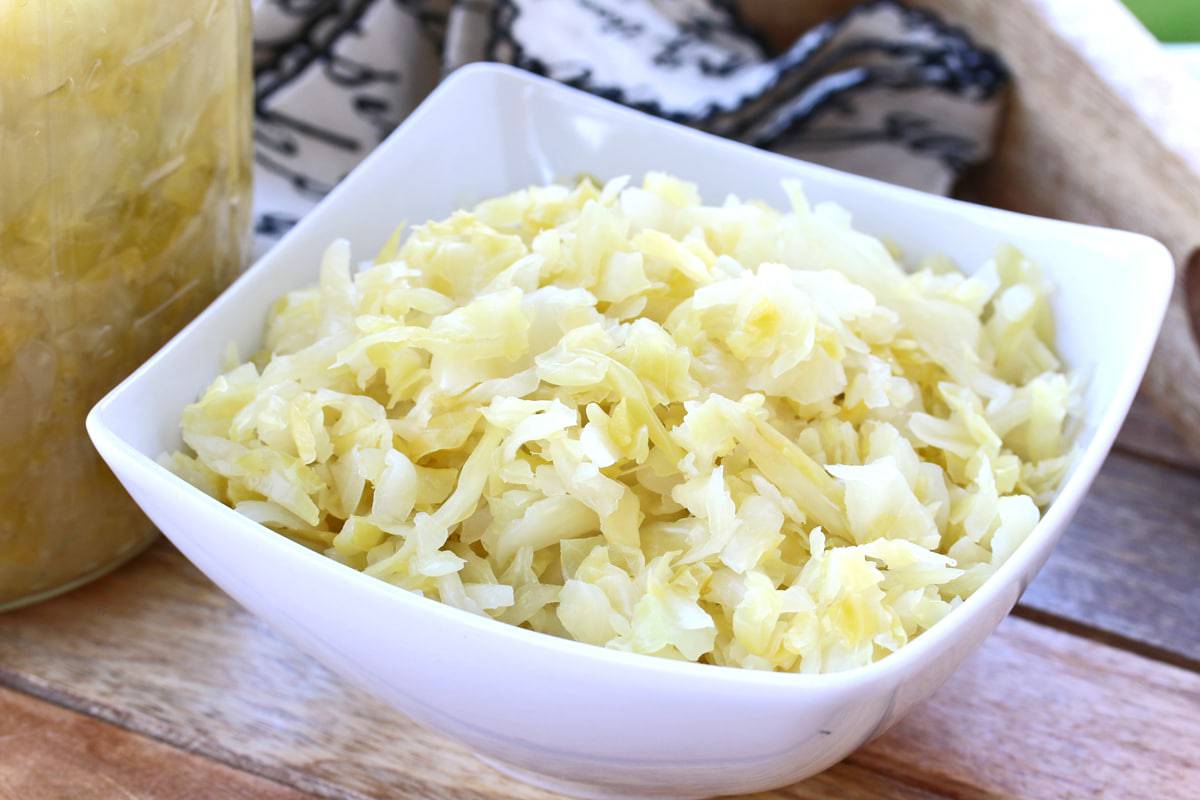
How Long Does Sauerkraut Keep?
Stored in a dark, cool place it will keep for many months. The cooler the storage area the longer it will keep. I keep mine stored in the fridge. Even in a cold environment like the fridge, sauerkraut will continue to ferment though at a much slower pace.
Can You Freeze Sauerkraut?
Yes, but just know that it will kill the probiotics. Cooking the sauerkraut will also kill the probiotics. So if your objective is to reap the benefits of the probiotics, eat it raw and unfrozen. If your objective is simply to enjoy it cooked as a delicious food (and delicious it is!), you will still reap the benefits of its vitamins and fiber.
How Long Does it Take to Ferment?
As long as you want it to until it reaches the desired texture and level of tanginess. Days. Weeks. Months. It will become tangier the longer it sits.
The length of the fermentation time will depend primarily on the temperature of the environment. The cooler the environment, the longer it will take to ferment. The warmer the environment the quicker it will ferment, the flavor will be inferior, and the sauerkraut is at greater risk of developing unwanted yeast and going bad. The ideal temperature for sauerkraut is 65-70 F. At that temperature we recommend letting it ferment for at least 2 weeks (preferably longer) but you can cut it shorter depending on your taste preference.
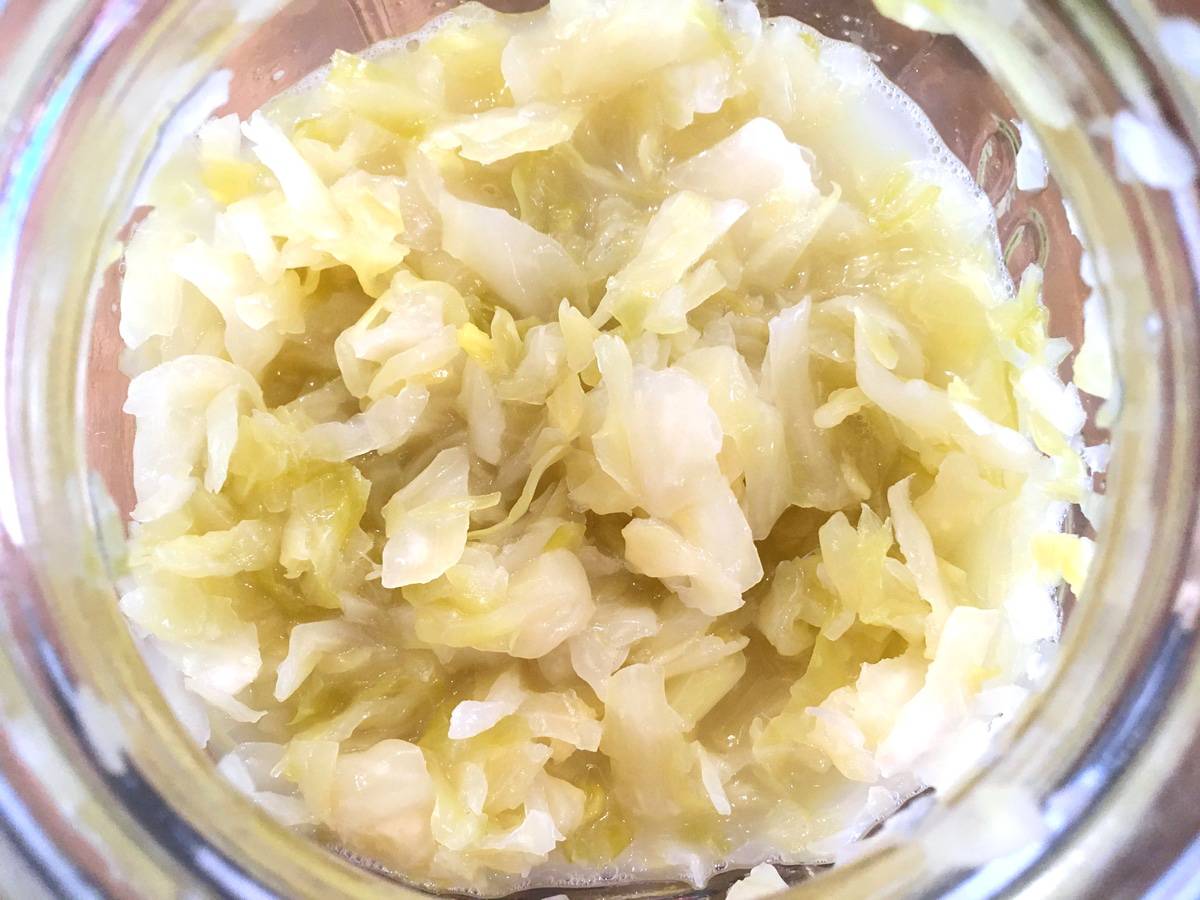
Can I Make Sauerkraut Without Salt?
While you can make sauerkraut without salt and you can find information on alternatives online, we do not recommend it. Salt is a key ingredient in fermenting foods for several reasons: 1) It creates an environment that favors the formation of lactobacillus bacteria (good bacteria) and prevents unwanted bacteria and yeast from forming, 2) It prolongs the shelf-life, 3) It helps preserve the vitamin and mineral content of the food, 4) It improves the flavor, 5) It helps keep the vegetables crisp and crunchy, and 6) It slows down the fermentation process so that the vegetables can develop a fuller, more complex flavor.
Fermented vegetables, including cabbage, do best with a salt content of 2-3%. Translated in measurements that’s 1 1/2 to 2 teaspoons of salt per pound of cabbage (9-12 grams of salt per 450 grams of cabbage).
Does Sauerkraut Go Bad?
While fermented foods are slower to go bad, they most certainly can and will in time. So how can you tell if sauerkraut is bad? See below.
There’s Mold On It: Is it Safe to Eat?
In most cases it is perfectly safe. Mold most often occurs when the cabbage isn’t submerged under the brine and comes in contact with air. When this happens it is perfectly safe to remove and discard the top layer of the sauerkraut. This is true if the mold is a greenish or grayish color. If however the mold is black, orange, or pink or if your sauerkraut has changed to an unpleasant color, slimy texture, or bad smell, then toss it.
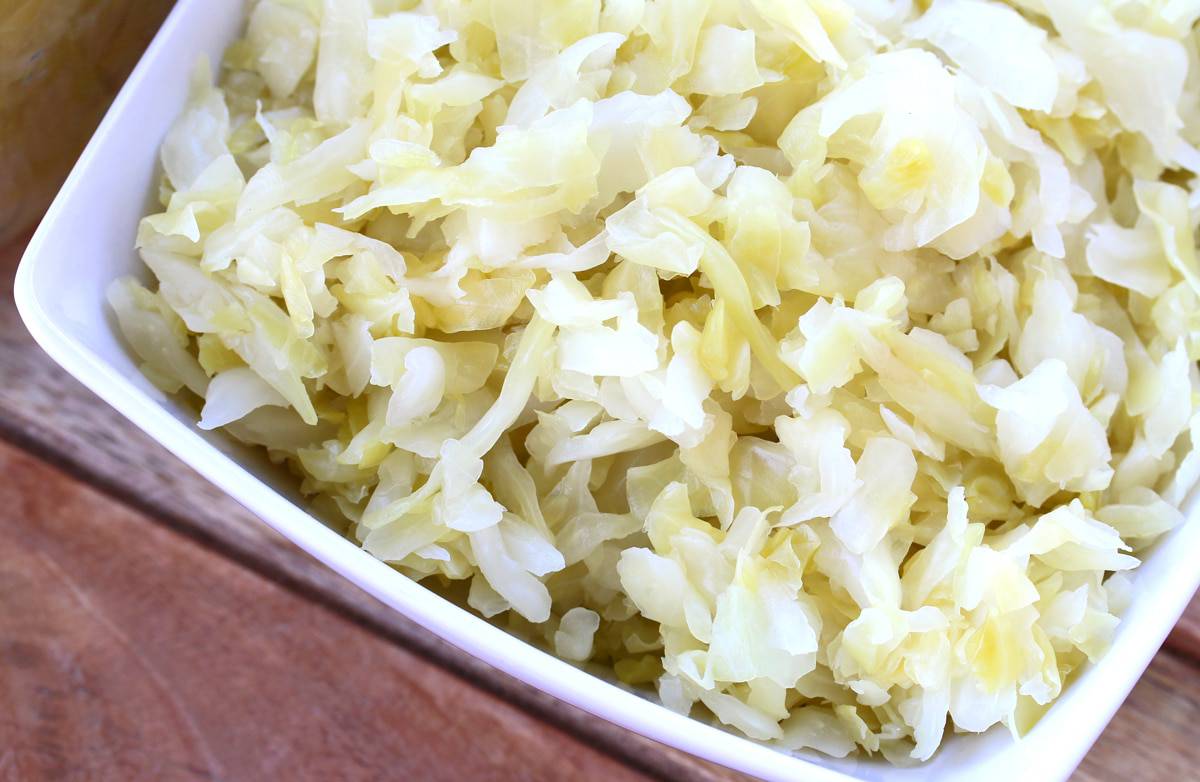
How to Make Sauerkraut
There are number of ways you can approach making sauerkraut but the overall method and principles are the same: Chop, salt, and keep the cabbage immersed under liquid until it’s fermented. There are also a number of flavor variations you can experiment with. For example, in Germany it is not uncommon to include whole, crushed juniper berries or caraway seeds.
I’m presenting a basic sauerkraut recipe but feel free to explore and experiment with flavors. Here a summary of the basic steps and below I’ll take you through those steps in detail:
- Chop the cabbage and place it in a large flat-bottomed bowl.
- Salt the cabbage.
- Pound the cabbage to release its juices.
- Transfer the cabbage to a glass or ceramic jar or crock and use a tamper to push the cabbage down into the jar to remove any air pockets until the cabbage is completely submerged under the brine.
- Place the lid on the jar, put the jar in a cool, dark place, and wait. Remove the lid every day to release air pressure, to make sure the sauerkraut is submerged under the brine.
- Taste the sauerkraut every day after the first few days until it reaches the desired texture and level of tanginess.
- Screw the lid on tight and store your finished sauerkraut in the fridge or a cool cellar.
Prepare the Cabbage:
Remove any bruised or damaged exterior leaves from the cabbage, then cut the cabbage in half and remove the core. Slice the cabbage very thinly, approximately 1/8 inch thick. For the best texture we recommend slicing it very thinly by hand, not with a food processor. You can slice it by hand, use a mandolin, or cabbage slicer.
Place the sliced cabbage in a large bowl and toss in the salt. Let it sit for about 20 minutes until the cabbage has begun to wilt and releases some of its juices. Use a tamper/pounder to crush the cabbage until it is wilted and has released a lot of liquid. This will take several minutes.
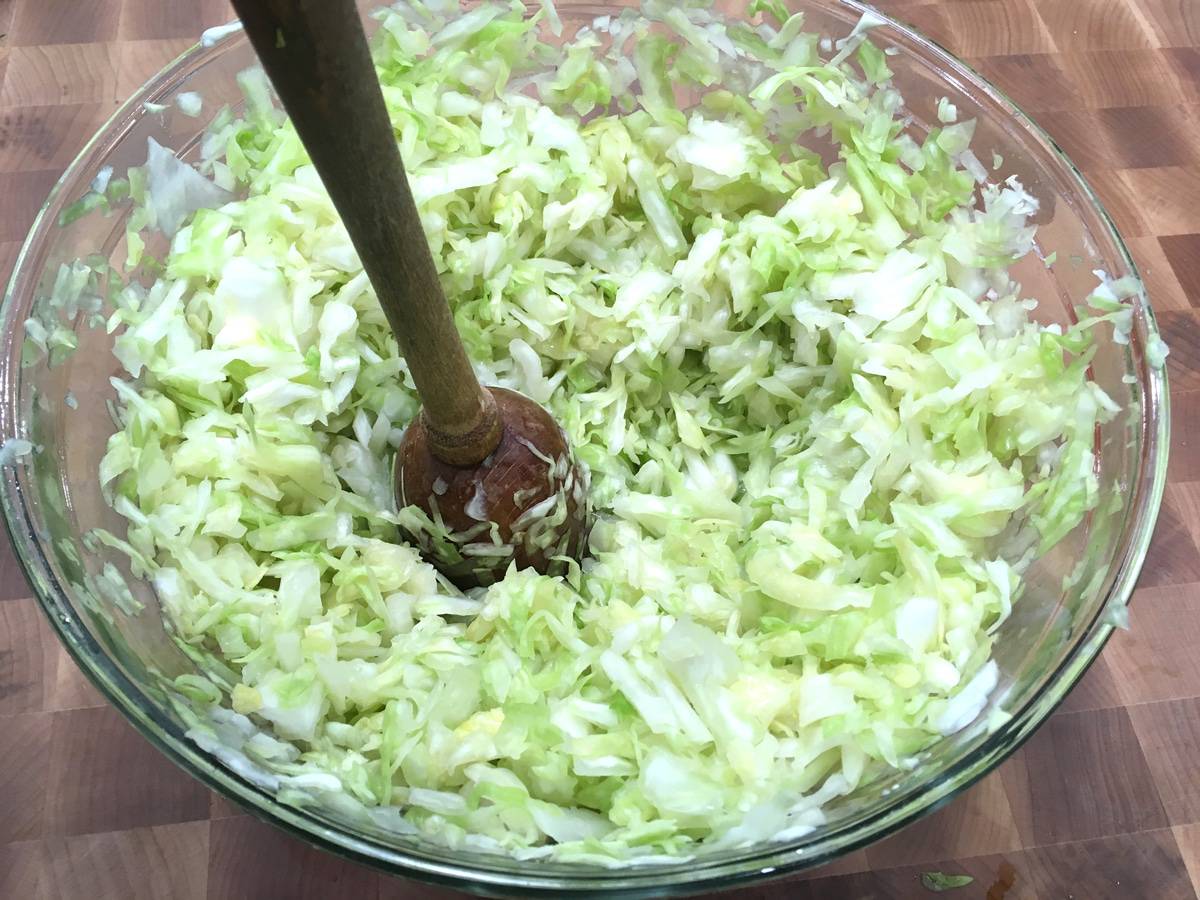
Pack the Cabbage into a Jar or Crock:
Transfer the cabbage and all the juices to a glass or ceramic jar or crock a bit at a time and mash it down with a tamper. Fill the jar to about 2/3 full (the cabbage will bubble as it ferments and could overflow if the jar is too full).
Continue to mash the cabbage with the tamper, releasing more juice, until the cabbage is completely submerged under the brine.
If you’ve mashed all you can mash and you still don’t have enough brine to cover the cabbage you’ll need to make some supplemental liquid that is consistent with the salinity of the cabbage brine: Dissolve 1 teaspoon of salt in 1 cup of water (a 2% salt water solution) and add that to the jar until the cabbage is completely submerged under the liquid.
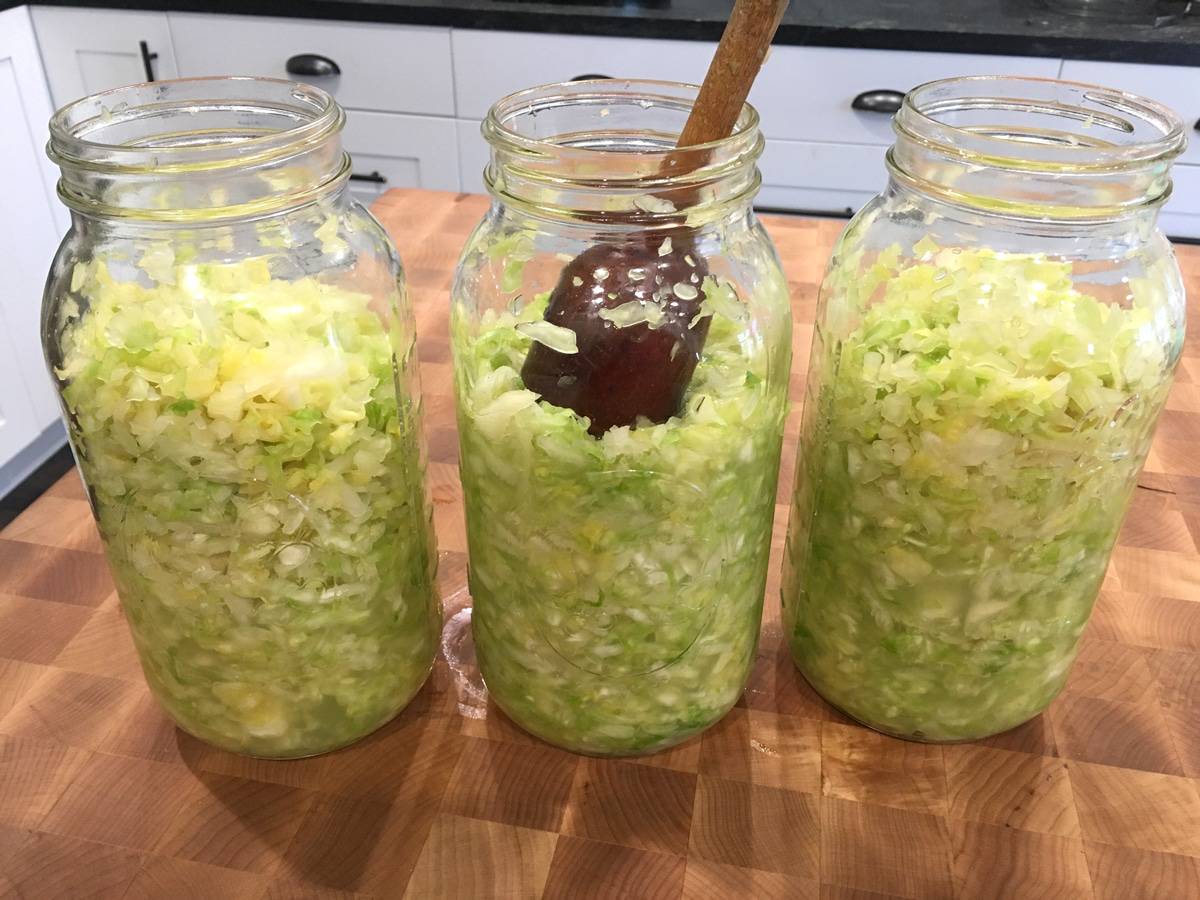
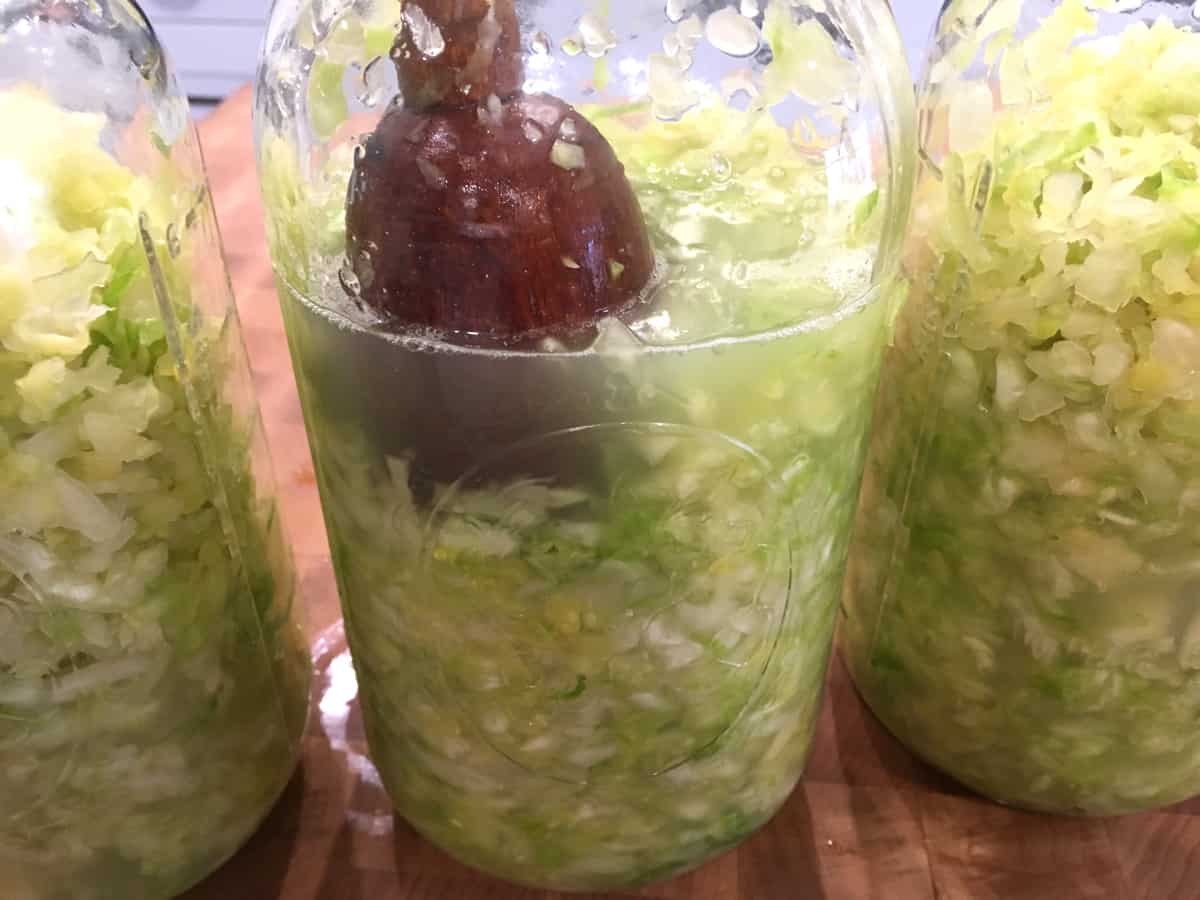
It’s also important to mash the cabbage to remove any air pockets in order to prevent mold growth.
The prep work is done.

It is imperative that the cabbage remain submerged under the brine during fermentation, otherwise mold will form (See section above “My Sauerkraut Has Mold on it: Is it Safe to Eat?”). To do this choose a heavy object whose diameter is roughly the same size to the inside of the crock you’re using. The object should be glass, ceramic, or non-reactive metal.
Note: I have made sauerkraut multiples times in large mason jars (usually 1/2 gallon size) without needing to use weights. Because of the small diameter of the jar, after a day or two of fermenting the cabbage usually remains below the liquid level. If the cabbage rises above it I just mash it back down with the tamper. If you choose to use mason jars without using something to weigh down the cabbage, just be sure to keep a close eye on it each day throughout the fermentation process.

Let the Fermentation Begin!
Screw on the lids to fingertip tightness. If using airlock lids, follow the instructions provided with your lids.
Place the jars in a dark place that is between 65-70 degrees F, the ideal temperature for fermenting. (See section above “How Long Does it Take to Ferment Sauerkraut” for information on temperature variations.)
Now it’s time to WAIT.
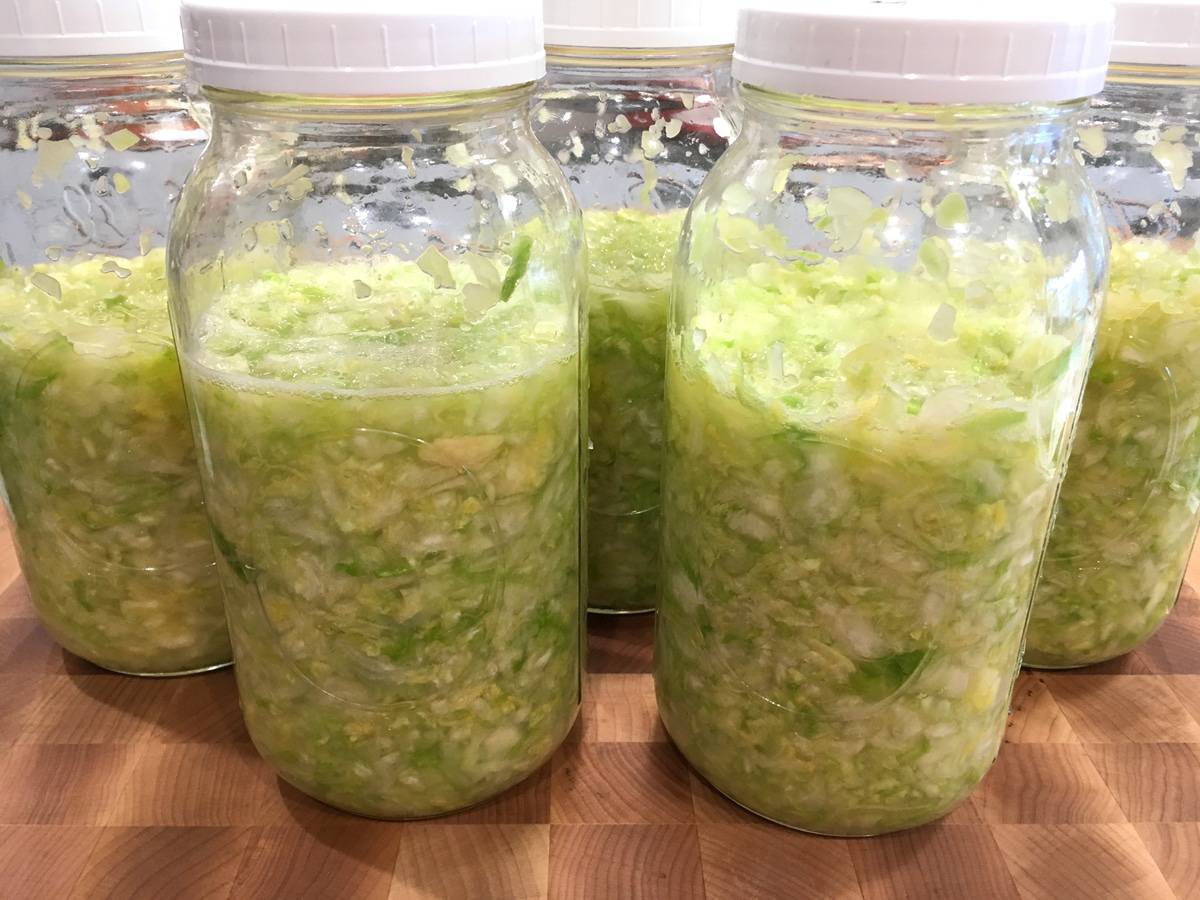
At a the ideal temperature range of 65-70 F we recommend fermenting the cabbage for at least 2 weeks (we recommend longer) but follow your own taste.
After 4 days of fermenting start tasting the cabbage daily until it reaches the desired texture and level of tanginess. Don’t be alarmed if the brine becomes fizzy, this is completely normal and a positive sign of microbial activity.
The color of the cabbage will change from green to a pale yellowish beige (in the pic below compare the green-colored cabbage in the jars, still in the early stages of fermenting, with the finished sauerkraut in the middle).
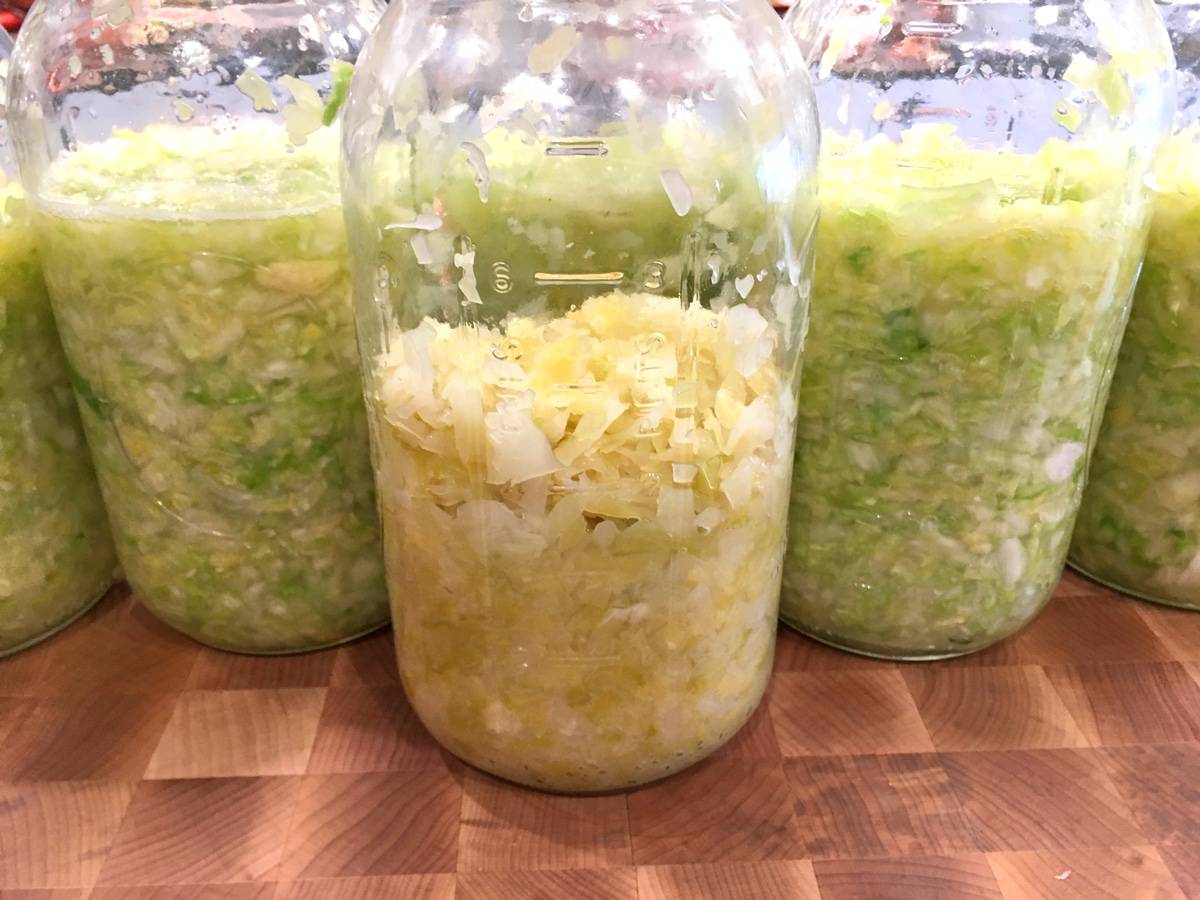
Once your sauerkraut has reached the level of tanginess that you want, it’s time to screw the lid on tight (remove the airlock lid if using and replace it with a regular lid).
Store the sauerkraut in the fridge or a cold cellar. The storage temp should be between 38-50 degrees F. Fermentation won’t stop but it will be greatly slowed down.
Stored in the fridge the sauerkraut will keep for many months. (See section above “Does Sauerkraut Go Bad?”) If your sauerkraut is too salty for your taste simply give it a rinse before eating.
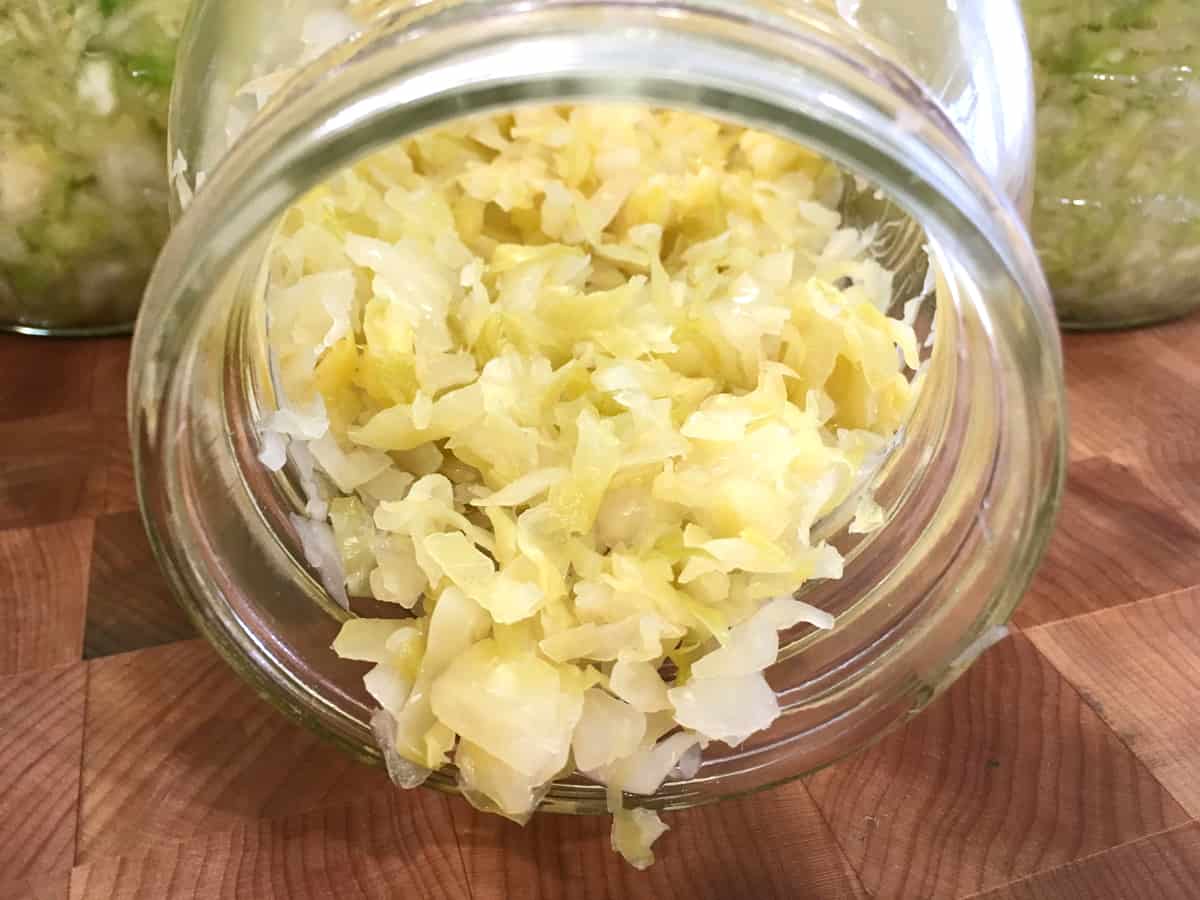
Eat your sauerkraut raw to reap the benefits of the probiotics or use it in any recipe calling for sauerkraut.
Enjoy!
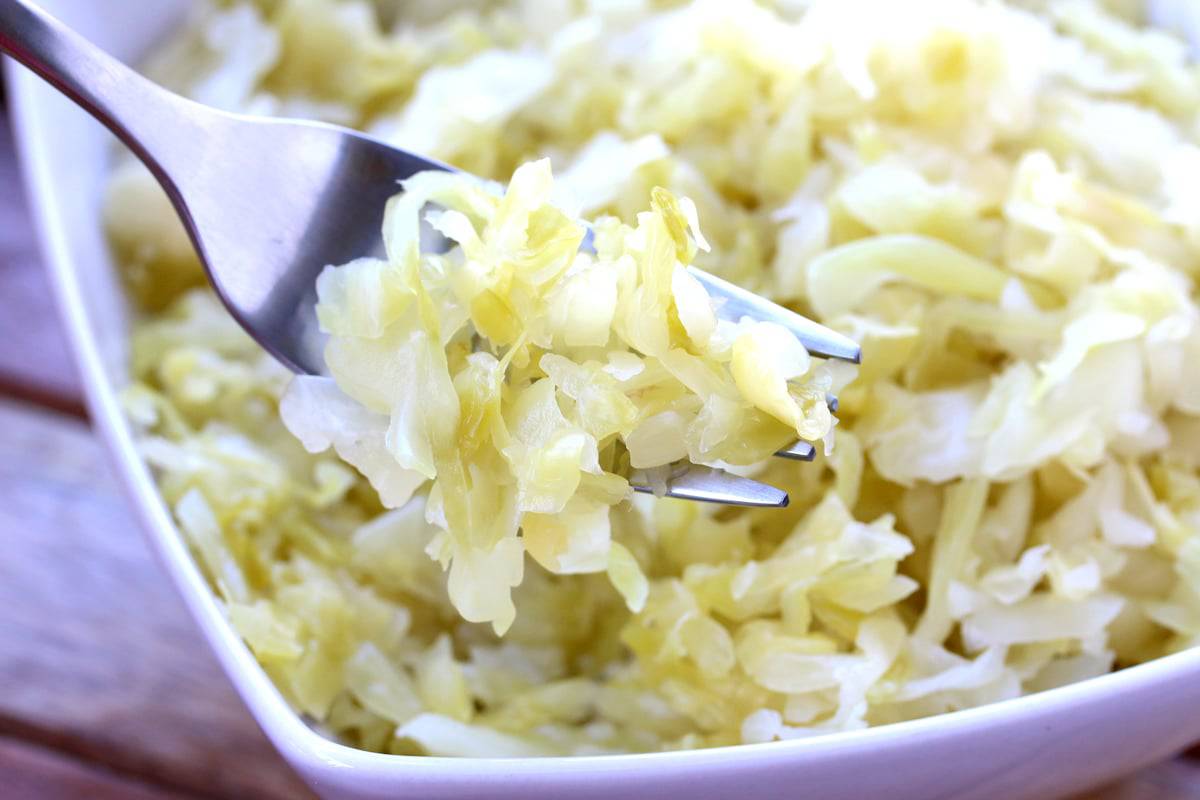
For sauerkraut recipe ideas be sure to try my:
Be sure to check out my tutorials on:
Save This Recipe

How to Make Sauerkraut
Equipment
- Jars I regularly use these ones!
Ingredients
- 1 1/2-2 teaspoons salt for every pound of cabbage (9-12 grams salt per 450 grams of cabbage) (use sea salt or kosher salt – avoid iodized salt because it can inhibit fermentation and make sure that whatever salt you use contains no anti-caking ingredients)
- very fresh green cabbage (The fresher the cabbage the more juice it will have to make a sufficient amount of brine. The finished sauerkraut will also have a much better texture.)
Instructions
- Prepare the Cabbage:Remove any bruised or damaged exterior leaves from the cabbage, then cut the cabbage in half and remove the core. Slice the cabbage very thinly, approximately 1/8 inch thick. For the best texture we recommend slicing it very thinly by hand, not with a food processor. You can slice it by hand, use a mandolin, or cabbage slicer.Place the sliced cabbage in a large bowl and toss in the salt. Let it sit for about 20 minutes until the cabbage has begun to wilt and releases some of its juices. Use a tamper/pounder to crush the cabbage until it is wilted and has released a lot of liquid. This will takes several minutes.
- Pack the Cabbage in a Crock or Jar:Transfer the cabbage and all the juices to a glass or ceramic jar or crock a bit at a time and mash it down with a tamper. Fill the jar to about 2/3 full (the cabbage will bubble as it ferments and could overflow if the jar is too full).Continue to mash the cabbage with the tamper, releasing more juice, until the cabbage is completely submerged under the brine and any air pockets have been removed (important for preventing mold growth). If you've mashed all you can mash and you still don't have enough brine to cover the cabbage you'll need to make some supplemental liquid that is consistent with the salinity of the cabbage brine: Dissolve 1 teaspoon salt in 1 cup water (a 2% solution of salt water) and add that to the jar until the cabbage is completely submerged under the liquid.It is imperative that the cabbage remain submerged under the brine during fermentation, otherwise mold will form (See blog section "My Sauerkraut Has Mold on it: Is it Safe to Eat?"). To do this choose a heavy object whose diameter is roughly the same size to the inside of the crock you're using. The object should be glass, ceramic, or non-reactive metal.Note: I have made sauerkraut multiples times in large mason jars (usually 1/2 gallon size but you can use smaller jars) without needing to use a weight. Because of the small diameter of the jar, after a day or two of fermenting the cabbage usually remains below the liquid level. If the cabbage rises above it I just mash it back down with the tamper. If you choose to use mason jars without using something to weigh down the cabbage, just be sure to keep a close eye on it each day throughout the fermentation process.Screw on the lids to fingertip tightness (this is important to prevent exploding jars!). If using airlock lids, follow the instructions provided.
- Ferment Your Sauerkraut:Place the jars in a dark place that is between 65-70 degrees F, the ideal temperature for fermenting. (See blog section "How Long Does it Take to Ferment Sauerkraut" for information on temperature variations.)At a the ideal temperature range of 65-70 F we recommend fermenting the cabbage for at least 2 weeks (we recommend longer) but follow your own taste.After 4 days of fermenting start tasting the cabbage daily until it reaches the desired texture and level of tanginess. Don't be alarmed if the brine becomes fizzy, this is completely normal and a positive sign of microbial activity.Note: If you're not using an airlock lid be sure to open the lid of your jar/crock every day to release the pressure and prevent your jar from exploding. The color of the cabbage will change from green to a pale yellowish beige.
- Store Your Sauerkraut: Once your sauerkraut has reached the level of tanginess that you want, it's time to screw the lid on tight (remove the airlock lid if using and replace it with a regular lid).Store the sauerkraut in the fridge or a cold cellar (storage temperature should be between 38-50 degrees F). Fermentation won't stop but it will be greatly slowed down. Stored in the fridge the sauerkraut will keep for many months. (See blog section "Does Sauerkraut Go Bad?") If your sauerkraut is too salty for your taste simply give it a rinse before eating. Eat your sauerkraut raw to reap the benefits of the probiotics or use it in any recipe calling for sauerkraut.
Originally published on The Daring Gourmet January 2, 2021



















What amazing timing! My doctor just put me on medication that requires that I get lots of probiotics to counter the effects. Jarred sauerkraut is always too firm, too sour, and not nuanced enough compared to what I’ve had in Germany and GOOD German restaurants here in the US (Kaiserhof in San Diego is my favorite)
I wrote to my Swabian cousins this morning looking for recipes, but unfortunately it seems that their grandmothers didn’t pass them down, so I came here looking for some, and what perfect timing.
I did have 2 questions:
1) I love caraway and juniper in mine, but do you have a suggestion on how much to add?
2) Although I’ll need to primarily eat it raw (for the probiotics), I also love cooked sauerkraut. My favorite places always end up with soft, relatively mellow bowls of deliciousness and I wasn’t sure if they just heat it, or add other things (meat products, onion, wine, who knows). Do you have any recommendations on recipes for cooking this sauerkraut?
That’s great, Steve, I’m so glad you found my site! How much caraway and juniper to use…that’s so individual and just comes down to how strong versus how subtle you want the flavor to be. For a 1/2 gallon full jar like I show in my pictures, I’d only use about 1/2 teaspoon (no more than 1 teaspoon) of caraway seeds and about 4 juniper berries (give them a swift pound with a blunt object to crack them open first) but I don’t like the flavors to be overly strong. I also prefer not to use caraway seeds if I’m eating the sauerkraut raw, only when I’m cooking it, but that’s just personal preference. For cooking the sauerkraut you can keep it as simple as just heating it up or you can “dress it up” by heating it up with a little white wine. My Oma would often cook the sauerkraut with a piece of Kasseler (German smoked pork) which made the sauerkraut taste amazing. You could also use something like a smoke ham hock. Alternatively you can also fry up some diced bacon, then add the sauerkraut and heat through, which is also really tasty. You can also heat up the sauerkraut in some beef or chicken broth for added flavor.
Have fun making sauerkraut and please let us know how it goes!
I have a question. I have been making sauerkraut successfully for years. However, I don’t pound the cabbage but immerse it in brine. It is much less labor intensive and comes out great. Are there any disadvantages to making it this way? Thanks.
Hi Claire, that’s a good question. Pounding/massaging the shredded cabbage ensures the cabbage is immersed in its own brine/cabbage water and it also slightly softens the sauerkraut while still remaining crispy. Immersing the shredded cabbage in brine without massaging or pounding results in product that’s more akin to the texture of kimchi (thicker, crunchier strands of cabbage), or simply pickled cabbage. In the end though it’s all a matter of personal preference and which texture you prefer. It also depends on how you eat the sauerkraut – i.e., eating it raw vs cooking and serving it as a German side dish.
Hi. My first attempt. I used a potato ricer to squeeze out the brine. Worked great and had the added benefit of packing down the cabbage. I put the packed cabbage in mason jar and added back the brine. Packed some more with a mortar from my mortar and pestle set. Added a full cabbage leaf to the top and packed again. Plenty of brine to cover it. Added a small jar to keep it all under the brine. I’ll open it every day to let out the pressure but I’m going away for a week so I read somewhere else to cover with a cloth held in place with a rubber band. I live in mexico where you can’t find sauerkraut so I’m pretty excited to try this. I can’t find applesauce eithe so I make that using pressure cooker. Simple. Now if I could just find out how to make horse radish life would be perfect. Going to try the pickle making too (yes I am Swiss German and Czech by heritage). Oh by the way. The ricer is also great for spaetzle
Do I use Kosher salt, pickling salt or table salt ?
Hi Val, use either kosher salt, pickling salt, or sea salt and just make sure that it doesn’t contain iodine or anti-caking agents. Avoid table salt because it contains iodine which can inhibit fermentation.
Kimberly,
I am so glad to see your recipe for Kraut. I have been making mine for some time and your recipe is almost exactly the same. As you mentioned the Caraway seed and juniper berries, I use that as well as some Bay leaf and a bit of dill interspersed with the cabbage as I pack it in my Sauerkraut crock to ferment. I also use one head of red cabbage to 2 heads of green to get a pinkish colored kraut that sets mine apart from others. The flavors the spices provide do make it a cut above anything you can buy in the store.
The other nice thing by having my own German style Sauerkraut crock is that I use it to make my own cold pack dill pickles and Kimchi. My great grandmother who immigrated in 1880 was known for her home cured Kraut I’ve been told. I did inherit her crock, slicing board and tamper she used but the crock has a crack and the mandoline is somewhat warped. Still cool to have.
My crock is the 5 liter one and came with the stone weights and tamper from Amazon about 6 or 7 years ago.
Those are such awesome heirlooms to have, Paul, that’s very neat. I have an antique wooden kraut mandolin, tamper, and crocks that I bought in antique stores in Germany but having that family connection makes it so much more meaningful. Hang on to those treasures! Another reader, Gerald Feldman, left a comment asking about dill pickles – do you have any tips or secrets you can share?
Kimberly,
Sure will. I’ll drop you an email on making pickles. To be honest a is very similar to making kraut just instead of salting the cabbage you make a brine.
The timing is the same depending on how crunchy you like the pickles to be befo
re you pull then out of the crock and put them in jars to refrigerate.
Hi Kimberly, I normally make my yogurt in a yogurt maker with a store bought starter. This method, makes a small batch and I want to use your recipe.
I would like to try this using my crock pot. A question though, After you have incorporated the old yogurt into the milk and close the lid, you say to cover with a large towel and let sit. My question is do you turn OFF the crockpot at this time or leave it on?
Thanks for your help.
BTW.. I love getting your posts and using so many of your recipes.
Thanks so much, Suzanne :) I just added some clarification – you turn off the slow cooker and then wrap a towel around it to help keep it warm. Let it sit in a room that’s at least room temperature (can be a little warmer too); if it’s too cool the yogurt won’t set. Good luck and please let us know how it goes!
I am excited to try this recipe and make my own Sauerkraut (Surchabis). Born and raised in Switzerland, I remember my mother making Sauerkraut in a big 30 gallon crock. She put a round wooden board with a heavy rock on top of the cabbage. She stored it in the cellar and checked periodically to make sure the cabbage was submerged.
Hello! Need some clarification. You said, “For example, in Germany it is not uncommon to include whole, crushed juniper berries or caraway seeds.” Are the whole? Or crushed? Or some of both? Thanks!
Hi Pearl, whole juniper berries are used and they are usually crushed (given a whack to slightly break them open) and the caraway seeds are added whole.
when are these added id like to try it
Hi Jo, just toss them in with the crushed cabbage and then stuff everything in the jar/crock.